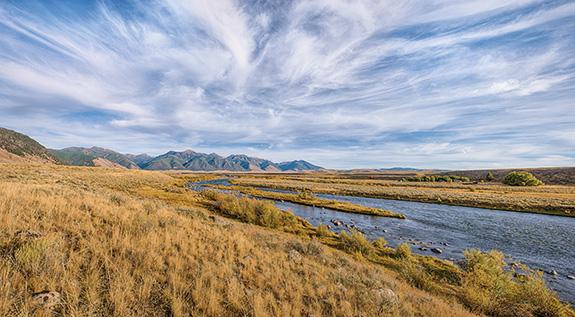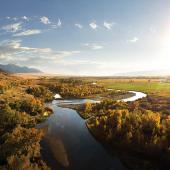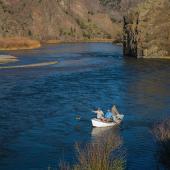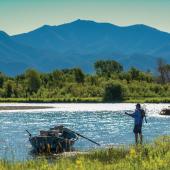Fall Into the Flow
Autumn in the upper Madison Valley.
Every sport has its iconic, generation-transcending locales: baseball has Yankee Stadium; golf, the back nine at Augusta; football, Green Bay’s Lambeau Field. And fly fishing has the Madison River. Steeped in lore and Western fly-fishing history, it’s on every fly fisherman’s worldwide bucket list. With cold, clean water, breathtaking scenery, eager and healthy trout populations, and plenty of access, it’s no wonder that the Madison continues to be the most famous trout stream in the country, and perhaps the planet.
But come fall, the upper Madison River and the mountains surrounding it offer so much more than just fishing. Whether you’re stalking elk in the Gravellys, sneaking in a late-season mountain-bike ride up Mile Creek, or hiking in the Taylor-Hilgards, the Madison Valley has you covered.
From the Yellowstone Park boundary, the Madison follows a leisurely course until it reaches Hebgen Lake, the largest of the Madison River impoundments. From here, the river flows a short distance to Quake Lake, an excellent spot for canoeing, sea-kayaking, and paddleboarding. Below Quake is the beginning of the “100-mile riffle,” a long, boulder-laden, trout-filled stretch that runs downstream to Ennis Lake. One of the secrets to the Madison’s abundant fish populations is that it has both the biomass and stable flows of a tailwater, with the variation in insect life and structure of a freestone. The river is quite possibly the perfect trout stream, and the adjacent ranges could keep you occupied for a lifetime.
Access
The upper Madison is blessed with numerous, well-developed access sites, along the river and in the surrounding mountains. A combination of FWP and BLM sites are conveniently located about every five river-miles, and are some of the best-developed sites in the state. Lyons Bridge and Palisades are a few favorites for float anglers. Valley Garden near Ennis and Reynolds Pass below Quake Lake are some of the wade fisherman’s favorite places to wet a line.
If you mountain bike, Mile Creek is a must-ride, and there are several other bucket-list trails just outside the prohibitive Lee Metcalf Wilderness Area. Also, the gravel and dirt roads of the grizzly-thick Gravelly Range offer miles of two-wheeled access. Just be sure to wear bright colors and keep Fido close—this range is a hunter’s domain.
If camping and day-hiking is your thing, you’ve got options. Whether you backpack into a backcountry site, or pay and stay at designated campgrounds, you’ll have no trouble sleeping under the stars now that the summer tourists have moved on. Riverside sites are highly recommended, such as Palisades. These are coveted in the summer, and difficult to get; come fall, your odds greatly improve.
The Fish
The Madison is known the world over for its hard-fighting rainbow and brown trout as well as mountain whitefish. The rainbow population has rebounded from its lows during the early ’90s and whirling-disease issues, thanks mostly to efforts to protect spawning fish and improvements in river management. Brown trout can be found river-wide and several specimens in excess of 25 inches are caught each season. The mountain whitefish, one of the true natives to the drainage, has come under hard times with population declines in the past few years. Cutthroat trout, once native and plentiful in the Madison, are now reserved as an oddity with strongholds in many of the feeder creeks.
Row vs. Wade
For the fisher folk, this is the million-dollar question, and luckily, this is where the Madison really shines. The river has two areas that are off-limits to boat-fishing, to cater to wade-only fishermen. Boats can be used to access the river, but fishing must be done with your feet in the water. The upper wade stretch is from the outlet of Quake Lake downstream to Lyons Bridge, and is characterized by fast riffle water and large boulders. The lower wade-only area is from Ennis Bridge downstream to Ennis Lake, known locally as the Channels. The Valley Garden access near Ennis is the only access to this heavily braided section of river. If you simply want to float the river and won’t be casting for trout, the flows come fall are still stout enough to get you downriver in a timely fashion.
Regs
Besides the areas set aside for wade fishing, the Madison has a few special regulations for fishermen to keep in mind. From Madison Junction downstream to where it exits Yellowstone Park, the river is under the authority of the National Park Service, and a special fishing license and regulations apply. From Varney Bridge to Quake Lake, the river is catch-and-release and restricted to artificial lures or flies only. Below Varney Bridge, anglers are allowed to keep brown trout as well as fish with bait. As always, check the annual regulations before hitting the river.
Getting There
The easiest way to fish the upper Madison from Bozeman is to follow Hwy. 84 to Norris, then take a left and proceed to the quaint fishing hub of Ennis. Stop by one of the local fly shops and pick the brains of some local experts, then proceed south on Hwy. 287, which conveniently parallels the Madison its entire length. Another option is to take the scenic route down Gallatin Canyon before hooking up with Hwy. 287 north of West Yellowstone.
John Way is an outfitter and the owner of the Tackle Shop in Ennis.





